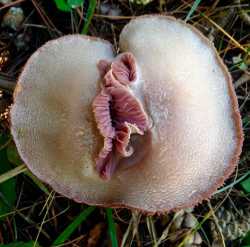the only one i know is that if it's a spongey mushroom (no gills) these are indications of it being toxic:
>red anywhere on the cap, stem, or bottom sponge part>cut it in half and smush, the bruise quickly turns bluethere's another mushroom that grows nearby to me, if you squeeze the gills a milk substance will come out of them. i know some of that type is edible, but most of them are toxic. so, if the mushroom produces milky substance, i avoid.
the problem of the milk test, and why i avoid, is because when the mushroom is mature, it will not make milk.
but, for safe measure, if the mushroom or any nearby similar looking, younger mushroom, produce milk, then i stay away.
to be honest, OP, I would spend time studying and bring a field guide for your area, and gain some familiarity with the mushrooms native to your species.
maybe decide on one type of mushroom you'd like to learn to ID as a start.
once you do learn to ID a mushroom or two, start going on some foraging adventures. my grandfather always told me to bring a mesh bag, especially for morel hunting, so you can spread pores as you walk.
finally, for morel mushrooms, they like birch trees and elm trees. I find them by the same old birch tree from my city every single year.
so, maybe it's also a good idea to learn "what plants do the edible ones like to grow near??"
Good luck!
>>2736073professor learned from book, and probably book written by man who also died of mushroom.
my grandfather, and the expert foragers of my town, learned from the professor mistake. they bring along the university man, and let him taste test all sorts of mushrooms. when he die, they say "ok, now we know to avoid this"
and thus they survive, unlike the book man.

